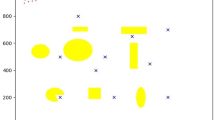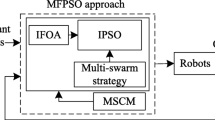Abstract
Target searching and tracking using a swarm of robots is a classical problem in the domain of robotics. The cooperation among the swarm robots has got increasing attention lately due to the different versions of the problem and complex environment. In this paper, a centralized control algorithm is proposed which utilizes cooperation among the swarm of robots for searching and tracking targets which is the velocity inspired robotic fruit fly algorithm (VRFA). The particle velocity concept of the particle swarm optimization is added to the fruit fly algorithm to improve the parameters such as local extremum and low convergence. The simulation results of the proposed technique in different scenarios demonstrate the effectiveness of the algorithm and its ability to keep tracking the targets until the exit condition matched. At last, the simulation result is shown with different environments and parameter settings.












Similar content being viewed by others
Availability of Data and Materials
The custom code could be made available as when required with conditional access.
References
Dadgar M, Jafari S, Hamzeh A. A PSO-based multi-robot cooperation method for target searching in unknown environments. Neurocomputing. 2016;177:62–74.
Dames PM. Distributed multi-target search and tracking using the PHD filter. Auton Robot. 2020;44(3):673–89.
Derr K, Manic M. Multi-robot, multi-target particle swarm optimization search in noisy wireless environments. In: Proceedings - 2009 2nd Conference on Human System Interactions, HSI 09, 2009. 2009. pp. 81–6.
Du Y. A novel approach for swarm robotic target searches based on the DPSO algorithm. IEEE Access. 2020;8:226484–505.
Gade R, Moeslund TB. Constrained multi-target tracking for team sports activities. IPSJ Trans Comput Vis Appl. 2018;10(1):1.
Gupta A, Bessonov D, Li P. A decision-theoretic approach to detection-based target search with a UAV, IEEE/RSJ International Conference on Intelligent Robots and Systems (IROS). 2017. pp. 5304–9.
Hu J, Xie L, Xu JZ. Multi-agent cooperative target search. Sensors. 2014;14(6):9408–28.
Khan A, Rinner B, Cavallaro A. Cooperative robots to observe moving targets: review. IEEE Trans Cybern. 2016;48(1):187–98.
Khan A, Yanmaz E, Rinner B. Information merging in multi-UAV cooperative search. In: IEEE International Conference on Robotics and Automation (ICRA). 2014, pp. 3122–9.
Lee G, Chong NY, Christensen H. Tracking multiple moving targets with swarms of mobile robots. Intell Serv Robot. 2010;3(2):61–72.
Li S, Li L, Lee G, Zhang H. A hybrid search algorithm for swarm robots searching in an unknown environment. PLoS One. 2014;9(11):1–10.
Lin L, Zhu MIN. Efficient tracking of moving target based on an improved fast differential evolution algorithm. IEEE Access. 2018;6:6820–8.
Lu M, Zhou Y, Luo Q, Huang K. An adaptive fruit fly optimization algorithm based on velocity variable an adaptive fruit fly optimization algorithm based on velocity variable. Int J Hybrid Inf Technol. 2015;8(3):329–38.
Luo J, Han Y, Fan L. Underwater acoustic target tracking: a review. Sensors (Switzerland). 2018;18(1):112.
Najd Ataei H, Ziarati K, Eghtesad M. A BSO-based algorithm for multi-robot and multi-target search. Lect Notes Comput Sci. 2013;7906:312–21 ((including Subser. Lect. Notes Artif. Intell. Lect. Notes Bioinformatics), LNAI).
Oh BS, Schenato L, Chen P, Sastry S. Tracking and coordination of multiple agents using sensor network: system design. Algorithm Exp. 2007;95(1):234–54.
Pan WT. A new fruit fly optimization algorithm: taking the financial distress model as an example. Knowl-Based Syst. 2012;26:69–74.
Papaioannou S, Kolios P, Theocharides T, Panayiotou CG, Polycarpou MM. Probabilistic search and track with multiple mobile agents. In: IEEE International Conference on Unmanned Aircraft Systems (ICUAS). 2019, pp. 253–62.
Parker LE. Distributed algorithms for multi-robot observation of multiple moving targets. Auton Robots. 2002;12(3):231–55.
Pugh J, Martinoli A. Inspiring and modeling multi-robot search with particle swarm optimization. In: IEEE Swarm Intelligence Symposium. 2007, pp. 332–9.
Qin R, Wang T, Jiang H, Yan Q, Wang W, Snoussi H. Cooperative target searching and tracking via UCT with probability distribution model. In: IEEE International Conference on Digital Signal Processing (DSP). 2016, pp. 560–4.
Ramasamy M, Ghose D. A heuristic learning algorithm for preferential area surveillance by unmanned aerial vehicles. J Intell Robot Syst Theory Appl. 2017;88(2–4):655–81.
Rayala SS, Kumar NA. Particle Swarm Optimization for robot target tracking application. Mater Today. 2020;33:3600–3.
Robin C, Lacroix S. Multi-robot target detection and tracking: taxonomy and survey. Auton Robots. 2016;40(4):729–60.
Senanayake M, Senthooran I, Barca JC, Chung H, Kamruzzaman J, Murshed M. Search and tracking algorithms for swarms of robots: a survey. Robot Auton Syst. 2016;75:422–34.
Sharma S, Sur C, Shukla AR, Tiwari, R. CBDF-based target searching and tracking using particle swarm optimization. In: Computational Vision and Robotics. New Delhi: Springer; 2015, pp. 53–62.
Shen Y, Yang J, Cheng S, Shi Y. BSO-AL: brain storm optimization algorithm with adaptive learning strategy. In: IEEE Congress on Evolutionary Computation (CEC). 2020, pp. 1–7.
Tang Q, Xu Z, Yu F, Zhang Z, Zhang J. Dynamic target searching and tracking with swarm robots based on Stigmergy mechanism. Robot Auton Syst. 2019;120:103251.
Tang H, Sun W, Yu H, Lin A, Xue M. A multirobot target searching method based on bat algorithm in unknown environments. Expert Syst Appl. 2020;141:112945.
Watchanupaporn O, Pudtuan P. Multi-robot target reaching using modified Q-learning and PSO. In: IEEE 2nd International Conference on Control, Automation and Robotics (ICCAR). 2016, pp. 66–9.
Yan F, Di K, Jiang J, Jiang Y, Fan H. Efficient decision-making for multiagent target searching and occupancy in Tan unknown environment. Robot Auton Syst. 2019;114:41–56.
Funding
Not applicable.
Author information
Authors and Affiliations
Contributions
The author is the sole author.
Corresponding author
Ethics declarations
Conflict of Interest
The author declares that he has no competing interests.
Ethical Approval
Not applicable.
Consent to Participate
Not applicable.
Consent to publish
Not applicable.
Additional information
Publisher's Note
Springer Nature remains neutral with regard to jurisdictional claims in published maps and institutional affiliations.
Rights and permissions
About this article
Cite this article
Garg, V. Cooperative Multi-robot Target Searching and Tracking Using Velocity Inspired Robotic Fruit Fly Algorithm. SN COMPUT. SCI. 2, 474 (2021). https://doi.org/10.1007/s42979-021-00880-6
Received:
Accepted:
Published:
DOI: https://doi.org/10.1007/s42979-021-00880-6




